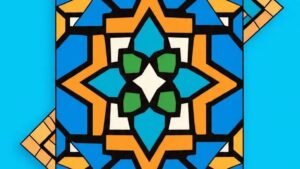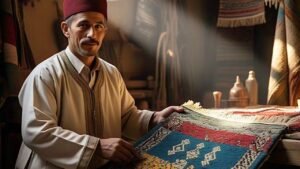
As you walk through the sun-dappled labyrinth of the ancient medina, you feel the pulse of history in every step, where handicrafts in Marrakech tell their timeless story. The scent of cedarwood and saffron fills the air, mingling with the clamor of artisans calling out to one another. Your fingertips graze the handwoven threads of a Berber rug, and suddenly, you’re connected to centuries of craftsmanship. The city is not merely a destination—it’s a living museum of artistry. Every object tells a story, every corner conceals a masterpiece, and every artisan is a guardian of tradition. Here, amidst the bustling life of the medina, you begin to understand why these crafts are celebrated worldwide for their soul and authenticity.
The Medina: Heart of Handicrafts in Marrakech

In the medina, life unfolds in a tapestry of vibrant hues and rhythmic sounds. This UNESCO World Heritage Site is a maze of narrow alleys where artisans shape their craft with unparalleled devotion. It is here that handicrafts in Marrakech flourish, reflecting the city’s rich heritage. From the shadowy depths of souks to sunlit courtyards, every step in the medina offers an invitation to marvel at human creativity.
Picture the Souk Semmarine, its archways adorned with lanterns casting golden light onto embroidered textiles and shimmering jewelry. Here, a silversmith hunches over his workbench, hammering filigree patterns into a bracelet that seems to capture moonlight. His tools, aged and polished by years of use, speak of a legacy passed from father to son. Every hammer strike feels like an echo of tradition, blending precision with reverence for the craft.
Wander further, and you’ll find leatherworkers at Rahba Kedima Square, their hands stained with the earthy hues of saffron and indigo. Babouches—Moroccan slippers—dangle from wooden racks like ornaments, each pair a testament to patience and precision. One artisan leans forward, his voice steady with pride, and says, “This dye is from my village. The technique is 200 years old.” His words resonate deeply, carrying the weight of heritage. In their craft, the artisans of Marrakech give life to objects that transcend utility, turning them into pieces of art imbued with cultural memory.
The Mellah: Secrets of the Silken Threads
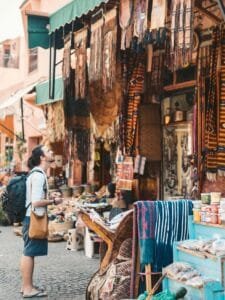
To the south of the medina lies the Mellah, Marrakech’s historic Jewish quarter. Here, another realm of handicrafts in Marrakech unfurls, one that whispers of silk and gold. The Mellah, once bustling with dyers, weavers, and tailors who adorned sultans and brides, still preserves its legacy of refined craftsmanship. Although quieter today, its streets carry the echoes of artisans who have shaped Marrakech’s reputation for beauty and excellence.
Imagine stepping into a weaver’s atelier, its air dense with the scent of wool and argan oil. Wooden looms creak under the weight of rugs being born, their patterns as intricate as constellations. A weaver, his hands calloused and steady, says, “Every knot holds a wish,” his voice tinged with both pride and nostalgia. As you watch his fingers glide over the loom, tying threads into a story only he fully understands, you begin to sense the sacred connection between the artisan and his craft.
The Mellah is also home to embroidery that captures the essence of Moroccan heritage. Caftans stitched with zellige patterns shimmer like mosaic tiles under the sun. Gold thread, known as “sfifa,” weaves through fabrics with the precision of poetry. A bride’s takchita, displayed in a shop window, seems alive, as if the hands that created it imbued it with their own spirit. These treasures are not mere garments—they are timeless works of art that connect past and present.
Dar el Bacha: A Palace of Craftsmanship
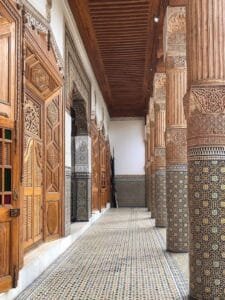
Dar el Bacha, once the residence of a powerful pasha, now stands as a shrine to artistry. Though its tiled courtyards and carved cedar doors seem like mere architecture, they represent the pinnacle of handicrafts in Marrakech. Stepping into Dar el Bacha feels like entering a world where every inch has been touched by the genius of Moroccan artisans.
In the palace’s zellige tiles, you see the mathematical brilliance of Moroccan mosaics. Tiny clay pieces, cut and glazed by hand, fit together with a precision that seems almost otherworldly. The colors—emerald green, cobalt blue, and sunflower yellow—remain vivid, a testament to the artisans’ mastery of timeless techniques. It’s as if the tiles themselves have captured the light and warmth of Marrakech’s sun, forever glowing.
The carved cedar ceilings whisper of Fassi woodworkers, whose chisels trace patterns older than the Qur’an. Their hands, steady and sure, transform wood into scripture, crafting pieces that feel sacred. A master craftsman, reflecting on his work, says, “It’s not just wood—it’s memory.” His words illuminate the deeper truth of Moroccan artistry: every carved arch, every painted panel, is an act of remembrance, a way of preserving cultural identity through beauty.
The Tanneries: Where Tradition Meets Earth
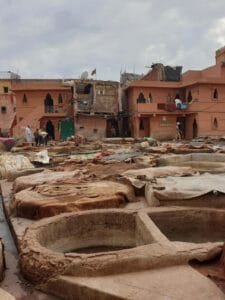
North of the medina lies the Tanneries, where the craft of leatherwork comes to life in the most visceral way. This is where handicrafts in Marrakech are born from the earth itself, shaped by ancient techniques that remain unchanged through time.
The scent of lime and pigeon droppings is overpowering, but it fades as you glimpse the vibrancy of dye pits—circles of red, yellow, and green like an artist’s palette. Men stand knee-deep in these pools, kneading leather with bare hands. The process is ancient, raw, and unrelenting, a testament to the resilience and skill of Marrakech’s tanners.
One tanner, his hands leathery as his wares, tells you, “This is life. The leather breathes; it feels.” He holds up a piece of cured hide, soft and supple, and you realize that in his hands, leather is not merely material—it’s a vessel for stories. From this labor come the bags, belts, and babouches that fill the souks, each item carrying the essence of Marrakech’s tanneries. In these humble workshops, the boundary between earth and artistry disappears, leaving behind objects that are as much a part of nature as they are of human ingenuity.
Beyond the Souks: Contemporary Handicrafts in Marrakech

While the medina is a treasure trove, Marrakech’s artisanship extends beyond its walls. A new generation of craftsmen is blending tradition with innovation, creating a fresh chapter for handicrafts in Marrakech. This modern evolution honors the past while reimagining it for a global audience, ensuring that the legacy of Marrakech’s artisans continues to thrive.
In the Gueliz district, ateliers buzz with creative energy. Here, contemporary designers collaborate with traditional artisans, merging old techniques with modern aesthetics. A ceramicist experiments with minimalist patterns, glazing bowls that balance simplicity and heritage. “We honor the past by reinventing it,” he says, his voice echoing with conviction. His work is a reflection of Marrakech’s adaptability, where timeless skills meet contemporary sensibilities.
At cultural hubs like Le Jardin and Maison de la Photographie, exhibitions showcase the evolution of Moroccan craftsmanship. A display of handwoven baskets, their natural hues accented with neon thread, captures the spirit of this transformation. These pieces are not just functional—they are statements, bridging time and place. As you explore this vibrant artistic movement, you come to realize that in Marrakech, craftsmanship is a living entity, always evolving, yet forever rooted in the rich soil of tradition.

